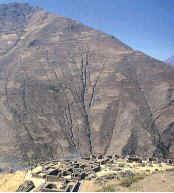|
The Sacred Valley of the Incas
The Area of the Valley Between Pisac and Ollantaytambo
is Known as the Sacred Valley of the Incas. It is a Long
Narrow Valley Which, in The Southern Region, Goes Back
up to Urcos and Towards the North, Crosses Ollantaytambo
Before it Finally Reaches the Citadel of Machu Picchu.
Over the Years, the Power of the IncasWas Consolidated
Due to the Expansion of Their Territories. The Terraces
are a Testimony of the Vast Production of Food, and the
Ollantaytambo Ruins Reflect the Ambitious Plans of the
Leaders of Cusco. The Best Time to Visit it is April-May
or September-October , the High Season is June-August.
The Rainy Season, From October to March,It is Cheaper
and the Weather isBearable and if You Have Warm Clothes
and an Umbrella or Raincoat You Will Not Have Issues,
Other Than That You are Ready to Visit Peru.
 Pisac
and its Citadel Pisac
and its Citadel
Pisac is Approximately 32 kilometers From the City of
Cusco. This Area Has Traditional Walls of Carved Stone,
Large Colonial Houses and Constructions where they Made
their Rituals, With a Complex Structure of Terraces and
Irrigation Channels. Pisaq is Well known for its Crafts
Market That is Opened Only on Tuesdays, Thursdays and
Sundays. The Trek to the Ruins Starts From the Plaza
Which Crosses the Terrace Gardens. The Beauty of the
Scenery is Spectacular. When You Climb to the Central
Part of the Ruins, you Will Reach the Temple of the Sun,
the Temple of the Moon and the Carved Stone Referred to
as Intihuatana. All of These Structures Express Evident
Astronomical Knowledge. The Area Reserved for What Could
be Called Storage(Tambo’s) Demonstrates the Importance
That the Incas Gave to the Conservation of the Crops.
From Pisac to Urubamba
From Pisac, Following the Vilcanota River Towards the
West, the Narrow Route Between the River and the Hills
Passes Through the Towns of Calca, Yucay and Urubamba
Before Arriving to Ollantaytambo. Yucay is Associated
With Some Important Events in the Incaand Colonial
History. In the Spacious Main Square you Will Find a
Beautiful, Impressive Tree, the Pisonay, Which Has Leafy
Branches and its Beautiful Flowers Give the Town an Air
of Festivity and Elegance. The Ruins of the Palace of
the Inca Huayna Capac Can Also be Found in This Area.
Urubamba is not Located Far From Here. Like Many Places
Along the Valley, Urubamba is in a Fine Setting With
Snow-Capped Peaks in View. It Has Many Restaurants and
Pleasant Dining Areas With Reasonable Prices. The Nearby
White Mountain Range Provides the Area With Scenery of
Extraordinary Beauty. The Town Offers the Visitor a Wide
Range of Possibilities to Rest, and Includes a Number of
Hotels and Similar Options. Ollantaytambo
The Town of Ollantaytambo is Located on the Opposite End
of the Pisac Valley. The Hanging Terraces GoingAbove the
Town are Superb. Likewise, the Curving Terraces
Following the Contours of the Rocks Overlooking the
UrubambaValley are Impressive. This was One of the Last
Areas in Which the Incas Made ConstructionsBefore the
Arrival of the Conquerors. Many of the Buildings That
were Begun in Pre-Hispanic Times Were Left Unfinished.
The Abandoned Stones and Unfinished Walls Remain as
Testimonies of the Battle in Whichthe Last Bastion of
the IncasAlong With Manco Inca Faced the Conquerors. The
Incas Retreated to the Vilcabamba, Jungle, an Area That
Served as a Final Refuge for What Remained of the
Political Legacy of the Incas.
Chinchero
Chinchero is Located Between Urubamba and Cusco. This
Area is Well Known For its Ruins and For the Lovely
Church Where you Can Find Many Artistic Painted Images
Fromthe Cusco School. It is Also an Appropriate Region
to View the Splendid Snow-Capped Peaks in the
Surrounding Area. The Church, the Houses Were Painted by
Diego CusiGuaman, as Well as Several Canvasses by Other
Artists. The Main Altarpiece is From the Seventeenth
Century and Represents the Virgin of Montserrat, to Whom
the Church is Dedicated.
Maras Salt Flats and the Circular Ruins in Moray
Maras, From Which One Can Reach the
Salt Flats and the Moray Ruins, is Located on the
Northwestern Side Before Entering Cusco. The Salt Flats
Display a Spectacle of Unusual Beauty. Located on a
Wide-Open Hill Above the Urubamba Valley, the Salty
Water Runs Along Channels, Which Extend Through the
Flooded Lands and Follow a More or Less Rectangular
Pattern, Depending on the Variations in the Land. The
Water, Which is Exposed to the Sun, Leaves Salt on the
Bed. Viewed From the Peak, the View of Rectangles Look
Like an Enormous Painting Designed by Nature. Inland,
not Far From Maras, One Can Find the Moray Ruins. There
are Three Semicircular Amphi-Theaters Used by the Incas
as a Sort of Open-Air Crop Laboratory. The Terraces
Arranged in Concentric Circles and Spread Out at
Intervals From the Lower to the Upper Region. For This
Reason, it is not Clear Enough What Role They Played.
The Structures of These Terraces Suggest Agricultural
Activity Which Used Many Factors of the Environment as
the Air Circulation the One Combined With the Circular
Area and the Advantages Offered by This Type of
Construction, Because They Used Water From Nearby
Regions.
|
